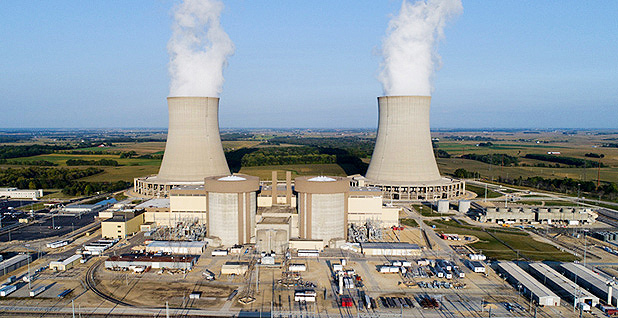Source: GlobalData Power Intelligence Center
Nuclear power will remain the dominant source of electricity generation in Bulgaria until 2030, despite the national government’s plans to add a substantial amount of renewable capacity this decade, says GlobalData, a U.K.-based data and analytics company. (According to a national strategy blueprint published on the Bulgarian parliament’s website last year, the country is targeting an additional 2,645 MW of installed capacity from renewable sources by the end of 2030.)
“Big Carl,” the world’s largest land-based crane, lifts the second of three prefabricated steel rings that will form the reinforced cylinder around the nuclear reactor at Hinkley Point C from its bunker to a lay-down area in late April. (Photo: EDF)
EDF has signed a new membership agreement with the United Kingdom’s Nuclear Advanced Manufacturing Research Centre (AMRC) to drive innovation in low-carbon power generation and support U.K. manufacturers, the University of Sheffield–based center announced recently.
New York’s Indian Point-3 was scheduled to close in April 2021.
At present, more than 20 commercial nuclear power plants in the United States have entered the decommissioning process, and many indicators point to a coming wave of additional plant closures. Indeed, with increasing numbers of plants terminating operations due to unfavorable market conditions, some voices have deemed this the “age of decommissioning.”
Regardless of whether a plant shuts its doors earlier than anticipated or seeks a life extension through relicensing, all plants eventually close. When they do, the closure sets off a wave of economic impacts ranging from minor disruptions to severe and long-lasting harm.
The Byron nuclear power plant
Illinois governor J. B. Pritzker’s proposal to subsidize the state’s Byron and Dresden nuclear plants, introduced in legislative form last week, falls short, Exelon Corporation President and Chief Executive Officer Chris Crane said on May 5 during the company’s first-quarter earnings call.
“From what we’ve heard, it’s open to negotiation, but just going from the street analyst opinion and what we’ve seen, its starting point is not adequate to keep the plants’ continued operations going,” Crane stated.
Artist’s rendering of Kairos Power’s KP-FHR reactor. (Image: Kairos Power)
The Tennessee Valley Authority and nuclear technology and engineering company Kairos Power this morning announced plans to collaborate on the deployment of the latter’s low-power demonstration reactor, dubbed Hermes, at the East Tennessee Technology Park (ETTP) in Oak Ridge, Tenn. TVA will provide engineering, operations, and licensing support to help Kairos with deployment, according to the announcement.
Unit 3 of the Vogtle plant under construction (Photo: Georgia Power)
To reach President Biden’s goal of cutting U.S. carbon emissions in half by 2030 and to have a net-zero carbon economy by 2050, some environmentalists are reconsidering their opposition to nuclear energy’s role as a climate crisis solution. According to the article, The controversial future of nuclear power in the U.S., from National Geographic, nuclear power has a lot going for it. Its carbon footprint is equivalent to wind, less than solar, and orders of magnitude less than coal. Nuclear power plants take up far less space on the landscape than solar or wind farms, and they produce power even at night or on calm days.
The above figure provides NYISO's projected mix of resource capacity expected to be available for the 2021 Summer Capability Period.
The figure below shows the vast difference in 2020 between clean energy provided to upstate New York and to downstate New York. With the recent closure of Indian Point-3, the difference will widen for downstate New York in 2021.
NYISO released its 2021 power trends report for the state of New York. As noted by many in the energy community prior to the closure of Indian Point nuclear power plant's Unit 2 and Unit 3 in 2020 and 2021, respectively, the projected mix of resource capacity expected for downstate New York's energy generation will be heavily reliant on fossil fuels.
The Surry nuclear power plant, near Surry, Va. Photo: Dominion Energy
The Nuclear Regulatory Commission has approved Dominion Energy’s application to renew the Surry nuclear power plant’s operating licenses for an additional 20 years. The renewed licenses authorize the extension of reactor operation at the two-unit plant from 60 to 80 years.


 A highly anticipated report released yesterday by the International Energy Agency on how to transition the world to a net-zero energy system by 2050 calls for “nothing less than a complete transformation of how we produce, transport, and consume energy.” At the same time, the report,
A highly anticipated report released yesterday by the International Energy Agency on how to transition the world to a net-zero energy system by 2050 calls for “nothing less than a complete transformation of how we produce, transport, and consume energy.” At the same time, the report,  Among the 12 energy-mix scenarios analyzed in
Among the 12 energy-mix scenarios analyzed in 


















